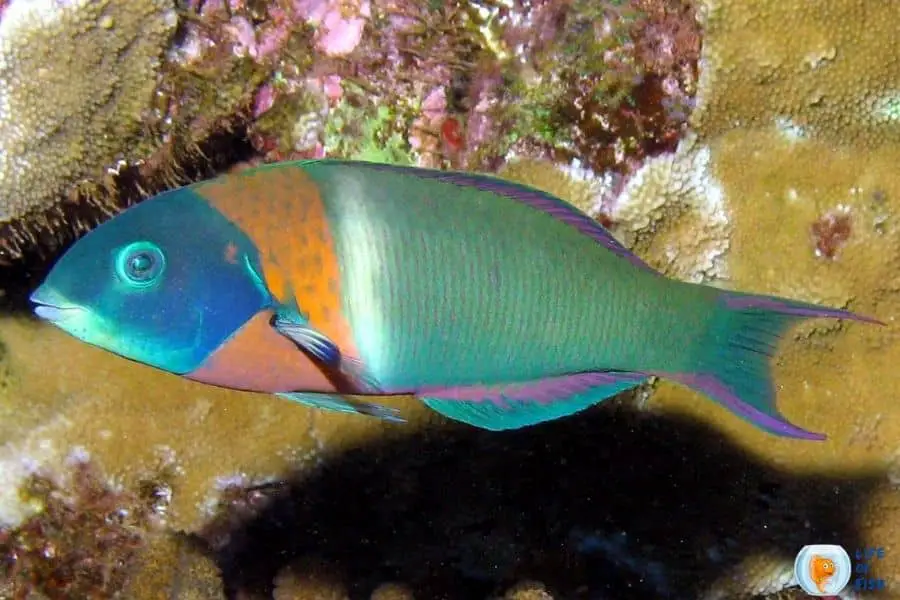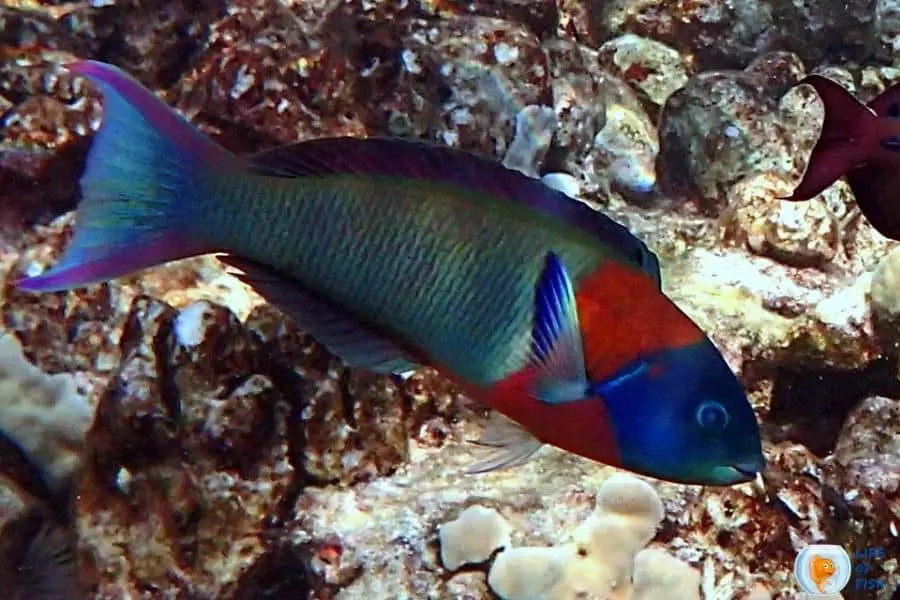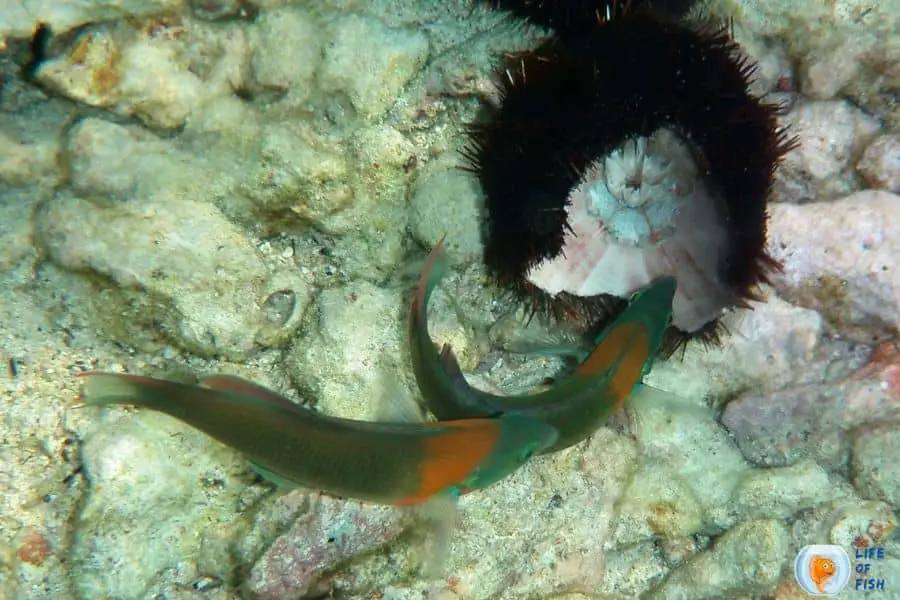All fish lovers, even beginners, love to keep or start with a beautiful fish variety. But most probably stunning and unique fish species are hard to keep. But now there is a brilliant option. You can start your journey from Saddle wrasse, and it will be amazing! Here, I share the most vital factors about the Saddle wrasse. So, read exciting details about them first!

One look Care Guide
Jump To
- 1 One look Care Guide
- 2 More about Saddle wrasse?
- 3 How big do Saddle wrasse get?
- 4 Are they aggressive?
- 5 Saddle wrasse behavior
- 6 How long does Saddle wrasse live?
- 7 Saddle wrasse care
- 8 Tank setup
- 9 Saddle wrasse breeding
- 10 Feeding Behavior Of Saddle Wrasse
- 11 What fish can live with Saddle wrasse?
- 12 Related Questions
- 13 Is Saddle Wrasse Aggressive?
| Scientific name | Thalassoma duperrey |
| Common name | Saddle wrasse Saddleback wrasse Duperrey’s wrasse Hinalea Luawili in Hawaii |
| Care level | Easy |
| Native to | Eastern Central Pacific, endemic to the Johnston and Hawaiian Islands |
| Type | Saltwater fish |
| Color | Orange, blue, and green decorate the body |
| Tank size | Minimum 75 gallons |
| Preferred temperature | 72 to 78 Fahrenheit |
| Other water parameters | pH level- 8.1 to 8.4 |
| Preferred salinity | SG 1.020 to 1.025 |
| Growth rate | No exact growth rate |
| Temperament | Semi aggressive |
| Recommended tank mates | Large angels TangsTriggers |
| Preferred food | Small crustacea Formulas Frozen foods such as Mysis Brine shrimps Flakes |
| Feeding frequency | 2 to 3 times |
| breeding | Difficult in captivity |
More about Saddle wrasse?
Quoy and Gaimard discovered this fish in 1824. Mainly this fish species is well known as Saddle wrasse, Saddleback wrasse, Duperrey’s wrasse, and Hinalea Luawili in Hawaii. As their name implies, they are a type of wrasse that belongs to the family Labridae or wrasse family.
So, where does Saddle wrasse live naturally? When we come to this, it is derived from the one name I mentioned above, “Hinalea Luawili in Hawaii.” Generally, this common reef fish can be found in the Eastern Central Pacific, endemic to the Johnston and Hawaiian Islands.
They commonly live in depths from 5 to 25m or 16 to 82 ft. It can be recognized as inhabiting shallow coastal regions to outer reefs. Plus, They prefer to enjoy sand bars for quick gateways. Mainly this fish species lives singly or in small formed groups consisting of one male with few female fish in the wild. They consider one of the most common reef fish.
Want to learn more about wrasse fish? Check out our comprehensive guide to these fascinating creatures!” – wrasse fish
Appearance Of Saddle Wrasse
In the initial phase, three distinct colors, blue, orange, and green, decorate the adult fish. Also, some lavender highlights give a stunning touch to their beauty. So, let’s check how these three colors cover the body of Saddle wrasse. A pretty blue head and a broad orangish “saddle-looking” bar enhance the uniqueness of the appearance of this fish.
The rest of the body comes in green color. There are secondary or terminal phases for this fish species’ life. It can be defined as the female having changed into a male. So, this type of male has a body covered with dark blue and green. As usual, when it comes to the juvenile stage, they are uniformly darker on the top of the body and lighter on the bottom.
How big do Saddle wrasse get?
They are not larger fish. Adult fish can reach up to 11.5 inches or 30cm in the wild. But when it comes to captivity, this size can be a little bit changed. Generally, they grows up to 6 -7 inches or 15-18 cm in captivity. But if you care about your fish well, you can go beyond this limit.
Are they aggressive?
They belong to the category of semi-aggressive. Though they become more aggressive as adults, they are peaceful in the juvenile stage. Especially, Saddle wrasse shows more aggression towards other wrasses.
Saddle wrasse behavior
They probably prefers to live in a single or small group. They do not have more company. Calm and quiet but can be fire. So, this fish species can be recognized as semi-aggressive fish. They exhibit a characteristic swimming pattern. They use their pectoral fins to mimic flying swimming patterns. This character is common among many wrasses in the family. But juvenile stage, they live peacefully. But this behavior totally changes when they become adults.
Adult fish are semi-aggressive, but they will be aggressive when you keep it with other wrasses. Not only that, wrasse is great jumpers, so, they should be the same, right? Generally, Saddle wrasse are active in the daytime, but they sleep at night.
In addition to that, we cannot recognize them as totally reef-safe fish. Because they may attack smaller crustaceans and invertebrates like flatworms, bristle worms, brittle starfish, and small shrimps. However, they do not bother corals.

How long does Saddle wrasse live?
There are no significant records related to the lifespan of them. However, according to my experience, I can conclude that Saddle wrasse can live an average of 5 to 7 years under proper care level and conditions. However, keep in mind this totally depends on the way you treat your fish and healthy level of the fish.
Saddle wrasse care
Tank size
Generally, they love to live in a tank with a large space. Hence, you should have at least 75 gallons or 284 litters aquarium, but do not try to fulfill the tank requirement at the minimum level. Always try to go with a large aquarium that is 75 gallons because it will allow you to keep an awesome fish tank without any headache. However, if you have a well-grown fish, you should go with a more than 80 gallons tank.
How many Saddle wrasse should be kept together?
Mainly, it is better to keep single fish in your tank. Especially if you are a beginner or your tank is not large enough to keep more than one. Also, they tend to make trouble with other wrasses because of their semi-aggressive behaviors. But you should have to keep more than one Saddle wrasse in your tank.
Firstly, you should check out the space of your tank. Secondly, you can decide the number of fish that you can keep in the same tank. But do not rush! You only can keep a small group due to their aggression. Here also, you can keep only one male Saddle wrasse in one tank. So how do you make a small group? Simply you only can keep one male with a few female fish.
Tank setup
The main thing you should keep in mind is to always try to mimic their natural habitat when setting up their tank. Similarly, they love to swim freely, so you have to leave adequate space to swim when setting up the tank decorations. It is always a must to use thick sandy substrate because Saddle wrasse loves to burrow.
Also, you can decorate the tank with a few live rocks and other rock works because these provide ideal spots for your fish to hide and sleep while adding extra beauty to your tank. Generally, almost all the wrasse are well-known jumpers. So tight lid will avoid jumping out of the tank of your fish. Plus, do not forget the importance of the filter system for your tank. Choose a high-quality filtration for your tank.
Water quality condition
If you experienced or saw a disaster that happened due to poor water quality, you can understand “why keeping the water parameters at a good level is essential?”. So, do not be careless about the water quality of your Saddle wrasse tank unless it will surely steal your sleep. So, keep the water parameters at ideal levels.
- Water temperature: it should be between 72 to 78 Fahrenheit.
- pH level: pH level should be best kept at 8.1 to 8.4.
- Salinity: they prefers to live where has SG 1.020 to 1.025.
However, there are no exact lighting conditions and water movements. On the other hand, water change is crucial to maintaining tank water quality. So, it is better to perform the water changes at 10% biweekly or 20% monthly.

Saddle wrasse breeding
Male or female identification
As usual, male fish has bright coloration with a variation of an orangish band behind the head. Female fish also has the same coloration but is not intense.
Breeding process
First of all, it should have informed that breeding them in captivity is difficult, and there are no significant records regarding this topic. Generally, you can find out Saddle wrasse singly or in harems, a small group of few female fish with a dominant male fish. However, most probably, they are born a female. But they are able to change irreversibly from female to male, and it is called protogynous hermaphroditism.
This process can be based on a response to a need in the environment or internal triggers. Further, you can identify female who changes their gender to become men clearly by the white stripe behind the red Saddle. Generally, when female fish starts to transition to male, they have to pass two primary phases. These are the initial phase male and the terminal phase male. At the terminal phase, the transition is complete, and the fish is 100% male.
In a harem, there will be only one dominant terminal phase male. This male fish is essentially the alpha male, aka super male. You can easily find out this dominant male fish because it is more vibrant and larger than females.
Sometimes, other males can be retained female colorations with the purpose of competing with the dominant male. However, now you know there are two types of males: the initial phase male and the terminal phase male. So, both males can mate. But they have different strategies.
Plus, the initial phase male has a larger teste than the alpha male. So, it has the ability to produce a large number of sperms. Consequently, initial phase, the male spawns as a group. But terminal phase super male spawn as pair while protecting their harem.
Feeding Behavior Of Saddle Wrasse
Like other wrasses, they are also a carnivore fish species. Therefore, they accept meaty foods. Plus, Saddle wrasse is an opportunistic feeder, and consequently, they will tend to eat whatever becomes available as they search for prey.
They may serve as cleaners in your aquarium in the juvenile stage. These little ones are picking parasites from other fish species that live with them. Another notable thing is that they have canine teeth and pharyngeal bones that are near their gills. These features give the best support to them to crush the shells of their prey.
What Saddle wrasse eat in the wild?
Generally, adult fish feeds on benthic animals such as shells, worms, mollusks, shrimps, brittle stars, and other crustaceans, while juveniles work as cleaners in the wild.
What does Saddle wrasse eat in the aquarium?
When it comes to foods that can be provided in the aquarium, they have a very hearty appetite. So, you can train your fish to eat prepared foods. Also, do not forget to provide a protein diet that is rich in small crustacea, formulas, and frozen foods. Here you are free to offer frozen foods like Mysis and brine shrimp. In addition to that, flakes are also a great addition to your fish’s diet.
How Often Should You Feed
They are heavy eaters and tend to eat anything. So, it is nice to provide food for your fish 2 or 3 times per day.
When Should You Feed (Time Of The Day)
Here the important thing is constantly to train your fish to get food at the same times of the day. However, if you decide to feed your fish two times per day, you can feed them in the morning and the evening. Or else, you can feed your Saddle wrasse in the morning, afternoon, and night if your selection is three times per day.
How Long They Can Go Without Food
In general, well-grown wrasse has the ability to survive in a few days without providing food. But the time period will highly depend on the availability of the food in your aquarium and the health level of your fish.

What fish can live with Saddle wrasse?
They are semi-aggressive. So, you can keep your fish with larger or similar size aggressive or semi-aggressive fish in the same tank. But keep in mind to avoid peaceful fish species. So, you can go with the below fish species.
- Large angels
- Tangs
- Triggers
In addition to that, do not choose crustacea and invertebrates as the tankmates of the Saddle wrasse. Because these small creatures definitely will be the food or snack of your fish. On the other hand, if you wish to choose other fish as tankmates, do not be a fool to keep male Saddles together. You can keep a few female with one male fish.
Related Questions
Is Saddle Wrasse Aggressive?
They are semi-aggressive. But Saddle wrasses are peaceful in the juvenile stage, and the aggressiveness of these fish will gradually enhance with their age. So, adult fish are semi-aggressive, and they will be more aggressive towards other wrasses, especially male fish. But Saddle wrasses do not hurt corals except crustacea and invertebrates.
Read Next : Carpenter’s Flasher Wrasse | Unique And Amazing Fish | Spotted Wrasse Care ( Look How Adorable They Are! )
